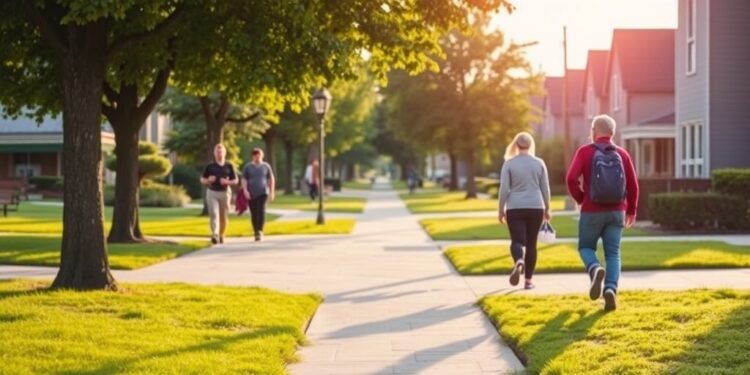Milan, Italy – A groundbreaking study presented at the ESC Preventive Cardiology 2025 conference has unveiled a critical link between neighborhood walkability and the risk of cardiovascular disease (CVD). The findings, declared on 3 April 2025, showcase a compelling narrative that urban planning and environmental design play a paramount role in public health, particularly regarding heart health.
The current public health scenario reveals unsettling statistics: over a quarter of adults do not participate in the recommended level of 150 minutes of moderate-intensity physical activity weekly. Dr. Erik Timmermans from the University Medical Center Utrecht presented these findings, emphasizing that neighborhoods designed for walkability could foster healthier lifestyle choices. With integrated features that promote walking, such as retail spaces and accessible green areas, residents are likely to opt for active modes of transportation. This not only enhances physical health but may also provide a buffer against CVD.
The concept of neighborhood walkability encompasses a multifaceted set of environment-specific characteristics. The researchers defined walkability as an interplay of land use mix, population density, green space density, and pedestrian-friendly infrastructure such as sidewalks. These features create an environment conducive for physical activity, thus addressing sedentary behaviors typically associated with car-dependent lifestyles.
The study embarked on a longitudinal exploration, analyzing data from 3,019,069 Dutch residents aged 40 and older, all of whom had no prior history of cardiovascular disease as of 2009. Over a substantial period, from 1996 to 2008, researchers calculated a nationwide, objectively measured walkability index based on residents’ homes. They meticulously constructed a walkability index composed of six vital components including land use density and sidewalk availability, with geographical data sourced from recognized health and geoscience consortiums.
Incidence data for CVD, spanning a decade from 2009 to 2019, was meticulously gathered through the Dutch Hospital Discharge Register and the National Cause of Death Register. By employing advanced Cox proportional hazards modeling, researchers managed to delineate associations between walkability trajectories and the subsequent onset of cardiovascular diseases. This robust methodology took into account various demographic and socioeconomic factors that might also influence health outcomes.
At the initiation of the study, participants had a median age of 57 years. The research revealed the emergence of four distinct trajectories concerning neighborhood walkability, ranging from stable low walkability, which encapsulated 91.1% of the sample, to a minor segment exhibiting stable high walkability at 0.6%. Additionally, trajectories indicated fluctuations in walkability, with a few individuals experiencing improved walkability while others faced declines.
Among those followed over a median period of 11.0 years, a staggering 21.4% developed cardiovascular disease, translating into over 81,600 deaths as a direct consequence of CVD. Individuals residing in neighborhoods characterized by consistently low walkability were found to carry a 5.1% elevated risk of developing cardiovascular conditions compared to those in neighborhoods that maintained a stable high walkability index. Interestingly, those experiencing increasing walkability also exhibited a 4.9% higher risk, suggesting that gradual improvements in one’s walking environment may not immediately mitigate existing health risks linked to past sedentary behaviors.
Dr. Timmermans underscored the implications of these findings, indicating that the majority of individuals in the study were subjected to low walkability environments over time. This situation poses serious risks for cardiovascular health. Even neighborhoods that showed an increase in walkability did not necessarily correlate with an immediate reduction in risk, potentially due to long-term patterns of inactivity and associated cardiometabolic risks that remain entrenched.
The research advocates for transformative urban planning initiatives aimed at enhancing walkability as part of a comprehensive strategy to combat cardiovascular disease. In light of the rising prevalence of CVD, the study urges municipalities to rethink urban designs to prioritize pedestrian-friendly communities, thereby fostering active lifestyles among residents.
Overall, these findings construct a cautionary tale that urges public health officials, urban planners, and policymakers to reconsider the layouts of neighborhoods, which could have profound long-term impacts on community health. By understanding the relationship between environmental characteristics and health outcomes, society can pave the way for healthier living environments that prompt physical activity and reduce the risk of cardiovascular diseases.
This research not only places emphasis on the socio-ecological aspects of health but calls for greater collaboration across health, urban planning, and community development sectors. Policymakers are encouraged to invest in creating environments that motivate walking, as these spaces may serve as the frontline in preventing cardiovascular diseases and cultivating healthier populations.
In conclusion, as cities continue to evolve, prioritizing walkability could well be the key to improving public health and enhancing overall cardiovascular health outcomes. This illuminating research provides vital insights that underscore the significance of thoughtful urban design, advocating for healthier communities and ultimately reducing the burden of cardiovascular disease.
Subject of Research: Relationship between neighborhood walkability and cardiovascular disease risk
Article Title: Changes in neighbourhood walkability and incident cardiovascular diseases: a population-based cohort study of three million adults covering 24 years
News Publication Date: 3 April 2025
Web References: ESC Preventive Cardiology
References: Meijer P, Liu M, Lam TM, et al. Changes in neighbourhood walkability and incident cardiovascular diseases. Environ Res 2025;274:121367.
Image Credits: European Society of Cardiology
Keywords: cardiovascular disease, walkability, public health, urban planning, physical activity




